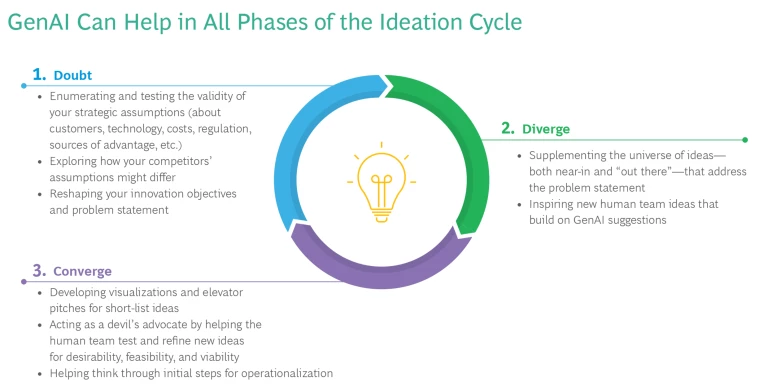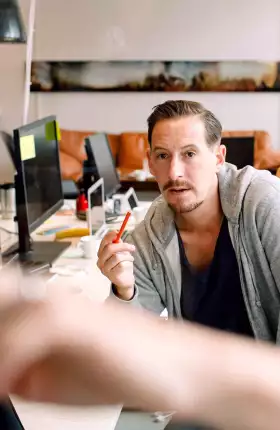A company’s efforts to innovate can fall short for many reasons. Critical assumptions about customers, technologies, rivals, and innovation domains may not reflect current trends and circumstances. The diversity and quality of ideas in the funnel may be too low. Or, the organization may struggle to identify, prioritize, and invest behind the best ideas.
Whether the focus is on new products, services, processes, or business models, Generative AI (GenAI) can enhance and challenge the work of teams across all phases of the ideation cycle. (See Exhibit 1.) GenAI’s most obvious contribution is in idea generation and validation—the divergence and convergence phases of innovation. Yet it can play an even more important role in helping leaders confront and update the strategic assumptions at the foundation of their business and innovation strategies : the doubt phase of the cycle. Organizations that regularly question their assumptions are more resilient because they are more likely to see, and position themselves to benefit from, the shifts on which competitive advantage turns.

Putting Doubt—and GenAI—to Work on Innovation
Innovation thrives on doubt , particularly in an era of disruption, and should be the first step of any creative exercise. We’ve long argued that thinking in new boxes beats thinking outside the existing box. Teams need structures within which to think—hypotheses about customers, technology, and the like to channel their creativity. Innovation teams that dive straight into the divergence phase without testing the soundness of their box risk trying to win at yesterday’s game—and merely getting to the wrong place faster.
So take the time to understand your existing assumptions, the “boxes” that contain and constrain your thinking, especially the hidden and implicit ones. And then stress test them—apply a doubt filter—before embarking on ideation. Which remain true and which are under strain? What combination of old and new assumptions should define the new box in which your ideation efforts should take place? Once defined and embraced, a new box for innovation creates urgency and focus: Why are we innovating? Where are we innovating?
GenAI can’t tell you when it’s time for a new box, but lacking the emotional bonds and biases that staff inevitably bring to an ideation effort, it can provide a valuable outsider’s perspective. By drawing on a vast body of knowledge, GenAI can make connections you might have missed that support or undermine the assumptions. Finally, the technology’s potential to confidently produce incorrect output and even “hallucinations” can, if played correctly, be an asset in helping teams rethink longstanding assumptions.
Unpacking the Boxes—and Creating New Ones
Generally, at the outset of the doubt phase of the ideation cycle, it’s a good idea to get all the key stakeholders together to identify and agree on the assumptions underlying your strategy. Which customer segments and priorities are you addressing and why? What are your key sources of competitive advantage in satisfying them, such as access to critical inputs, scale, and technological superiority?
Next, pressure test the assumptions. These old mental models may or may not remain valid. Are there signs that your chosen customers are growing less attractive or that their priorities are shifting? Are costs, technologies, or the competitive landscape evolving in ways that challenge your advantage?
Where assumptions are no longer valid or under pressure, lay out for each exactly how it needs to change—typically using a “from → to” exercise. This is especially important when the “from” is something hidden or implicit, like “this is how we’ve always done it” or “this is how everyone does it.” An example would be jet engine manufacturers moving from selling individual engines and separate maintenance services to selling hours of committed engine uptime. The “from → to” process sparks fresh, transformational thinking—and defines your “new box” for innovation.
Gen AI can help by coming up with potential assumptions you may have missed or identifying early warning signs that long-held, core assumptions may be reaching their expiration dates. Consider a simple GenAI prompt like, “I’m the CEO of [company name] and am kicking off a strategic review. What ten critical assumptions do you think are at the heart of my strategy—and for each, which do you think remain valid, which are invalid, and which are in danger?” The response can provide intriguing, enlightening, and valuable input for a leadership team exploring paths to innovation. Even GenAI information that comes from left field or seems off-the-wall can be useful if it forces the team to consider the argument thoughtfully before rejecting it. The key is to help the team break down constricting boxes.
Had GenAI been around in the 1980s, could it have helped department stores identify the fault lines under their strategies? They had long prospered by offering a broad, but not deep, selection of moderately-priced goods to the middle classes. For example, GenAI might have pointed out early signs of rising income inequality as the ratio of CEO pay to that of the average worker doubled between the late 1970s and late 1980s. It could have highlighted the rise of both low-end discounters and luxury specialty stores. It could have given executives permission to imagine a different and less hospitable strategic environment—and time to craft a response.
Getting Ideas on the Table
The next phase of innovation, divergence, entails generating a set of ideas that fit within your new or modified “box,” while otherwise withholding judgment. The goal is variety—eliciting as many fresh approaches as possible to rise to the innovation challenge. After all, the best way to have a good idea is to have many. And GenAI, well deployed, can make a big difference at the top of the innovation funnel. BCG’s 2023 global innovation survey found that organizations seeing impact from incorporating AI into their innovation systems generated five times more ideas compared with those that reported no benefit from using AI.
The divergence phase is all about asking questions, the right questions, to elicit useful ideas—from teams of people as well as GenAI. We hear a lot about the skyrocketing demand for “prompt engineers,” professionals who shape queries to ensure the best GenAI results. Yet this process isn’t new; trained innovation facilitators have been leveraging structured questioning techniques for years to improve the quality and diversity of the ideas they draw out from human teams. It’s no surprise that AI chatbots benefit from similar structuring.
The divergence phase of the ideation cycle is all about asking questions to elicit useful ideas—from teams of people as well as GenAI.
To keep their innovation muscles limber—and to ensure engagement in both the activity and its outcomes—it makes sense for the human team to start the questioning process. GenAI can be brought in later to open the aperture and toss more ideas into the hopper. You can ask it to generate a long list of ideas, adjusting the “temperature” or randomness of its analysis to ensure a healthy mix of incremental and more wild ideas. You can direct it to develop ideas based on analogies from other industries. Ask it to list specific reasons a stakeholder might be raving excitedly about one of your products in the future, which can open new pathways for ideas, or to lay out what opportunities might emerge from a specific trend or input. Ask for creative solutions not only for new product ideas, but for process redesign or cost-cutting challenges or any issue you are facing where fresh possibilities could be needed. These might be great ideas in their own right, or they may spark new thinking or enhance existing ideas from the team.
One important point to recognize is that—given the training set of data on which it relies —GenAI is likely to give a competitor the same or similar answers to these types of questions. So, it’s essential for the innovation team members to take the ideas to the next stage by applying the lens of their organization’s competitive advantages to the process. How can an interesting idea from GenAI be strengthened by leveraging the organization’s purpose, specific expertise, customer or supplier relationships, scale, and the like?
Separating the Wheat from the Chaff
Having a lot of ideas is great, but resources are finite. So it’s essential to find a way to select the most attractive ones to pursue among all those generated in the divergence phase. Let the humans start the process by creating a manageable list of the ideas that feel most exciting. Then bring in GenAI to help winnow down the options in the funnel—evaluating their relative desirability, viability, and feasibility—and then to assist in refining the concepts on the short list.
GenAI can, of course, help with concept refinement and visualization, producing compelling images and elevator pitches that can be tested with sales, marketing, and customers. But importantly, as in the doubt phase, it can be used as a devil’s advocate, leveraging its vast trove of data to challenge ideas. For example, Innovation CoPilot—a proprietary BCG tool currently in development—is a GenAI chatbot. By iteratively challenging ideas at each stage of the ideation cycle, it helps teams enrich and improve them.
While GenAI can provide substantial help on the road to innovation, human insight remains essential—both for coming up with new ideas and bringing them to life. After all, organizations are still led and staffed by people. To implement strategies, they need to understand, support, and be excited about them. They need to be proud of new products, services, and business models if they are to promote them. They need to remain part of the innovation and commercialization process.
Think of GenAI then as an amazingly fast, tireless, and smart intern who produces large quantities of output, but who isn’t always going to be right. Its role is not to take humans out of the creative process, just to make them better at it by pointing out old assumptions that box them in and stymie the quest for true innovation.











